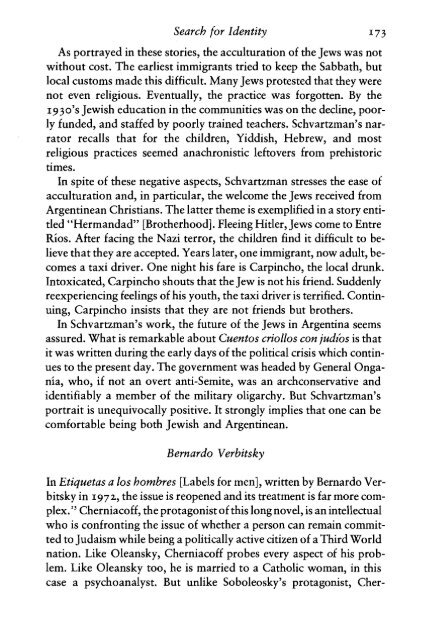Introduction - American Jewish Archives
Introduction - American Jewish Archives
Introduction - American Jewish Archives
You also want an ePaper? Increase the reach of your titles
YUMPU automatically turns print PDFs into web optimized ePapers that Google loves.
Search for Identity 173<br />
As portrayed in these stories, the acculturation of the Jews was not<br />
without cost. The earliest immigrants tried to keep the Sabbath, but<br />
local customs made this difficult. Many Jews protested that they were<br />
not even religious. Eventually, the practice was forgotten. By the<br />
1930's <strong>Jewish</strong> education in the communities was on the decline, poor-<br />
ly funded, and staffed by poorly trained teachers. Schvartzman's nar-<br />
rator recalls that for the children, Yiddish, Hebrew, and most<br />
religious practices seemed anachronistic leftovers from prehistoric<br />
times.<br />
In spite of these negative aspects, Schvartzman stresses the ease of<br />
acculturation and, in particular, the welcome the Jews received from<br />
Argentinean Christians. The latter theme is exemplified in a story enti-<br />
tled "Hermandad" [Brotherhood]. Fleeing Hitler, Jews come to Entre<br />
Rios. After facing the Nazi terror, the children find it difficult to be-<br />
lieve that they are accepted. Years later, one immigrant, now adult, be-<br />
comes a taxi driver. One night his fare is Carpincho, the local drunk.<br />
Intoxicated, Carpincho shouts that the Jew is not his friend. Suddenly<br />
reexperiencing feelings of his youth, the taxi driver is terrified. Contin-<br />
uing, Carpincho insists that they are not friends but brothers.<br />
In Schvartzman's work, the future of the Jews in Argentina seems<br />
assured. What is remarkable about Cuentos criollos con judrbs is that<br />
it was written during the early days of the political crisis which contin-<br />
ues to the present day. The government was headed by General Onga-<br />
nia, who, if not an overt anti-Semite, was an archconservative and<br />
identifiably a member of the military oligarchy. But Schvartzman's<br />
portrait is unequivocally positive. It strongly implies that one can be<br />
comfortable being both <strong>Jewish</strong> and Argentinean.<br />
Bernardo Verbitsky<br />
In Etiquetas a 10s hombres [Labels for men], written by Bernardo Ver-<br />
bitsky in 1972, the issue is reopened and its treatment is far more com-<br />
plex." Cherniacoff, the protagonist of this long novel, is an intellectual<br />
who is confronting the issue of whether a person can remain commit-<br />
ted to Judaism while being a politically active citizen of a Third World<br />
nation. Like Oleansky, Cherniacoff probes every aspect of his prob-<br />
lem. Like Oleansky too, he is married to a Catholic woman, in this<br />
case a psychoanalyst. But unlike Soboleosky's protagonist, Cher-

















